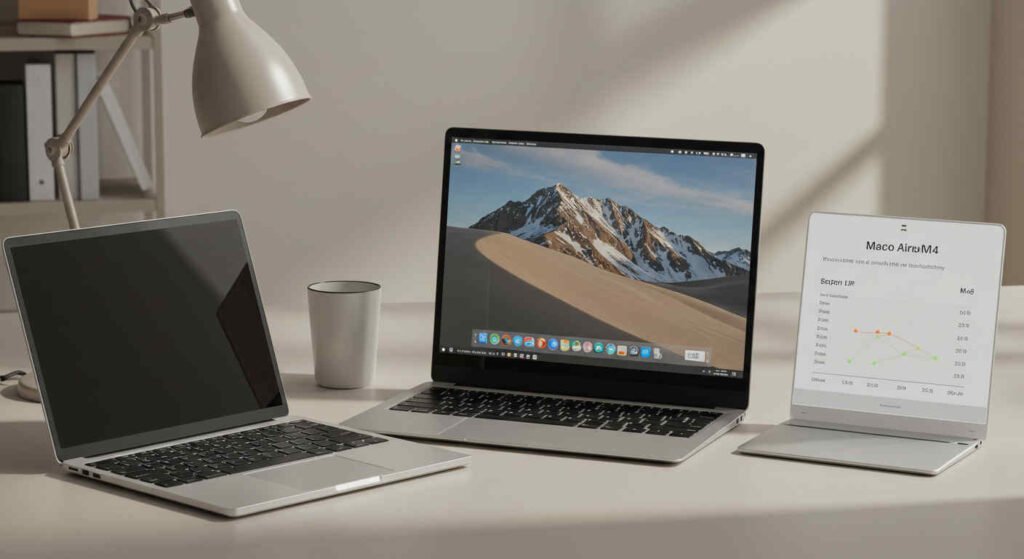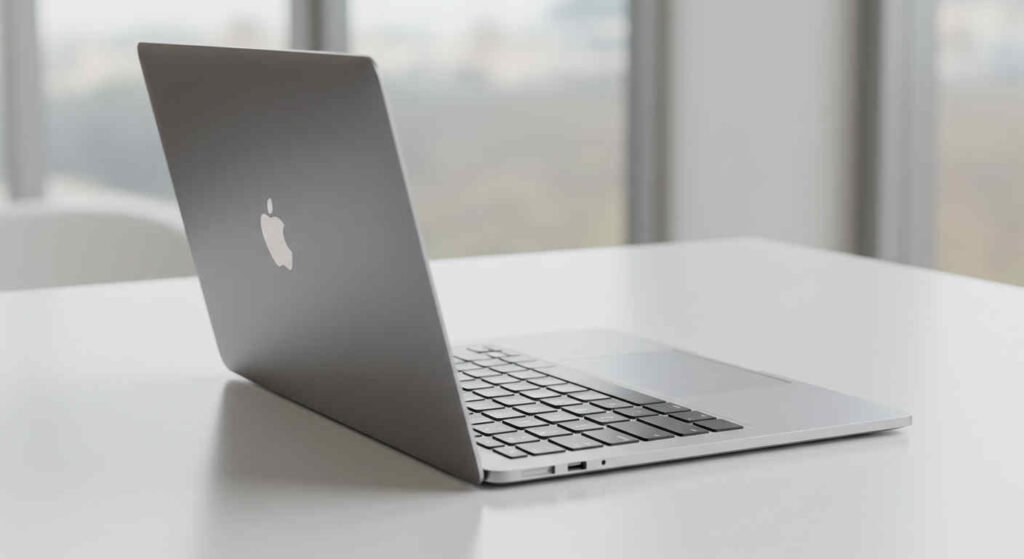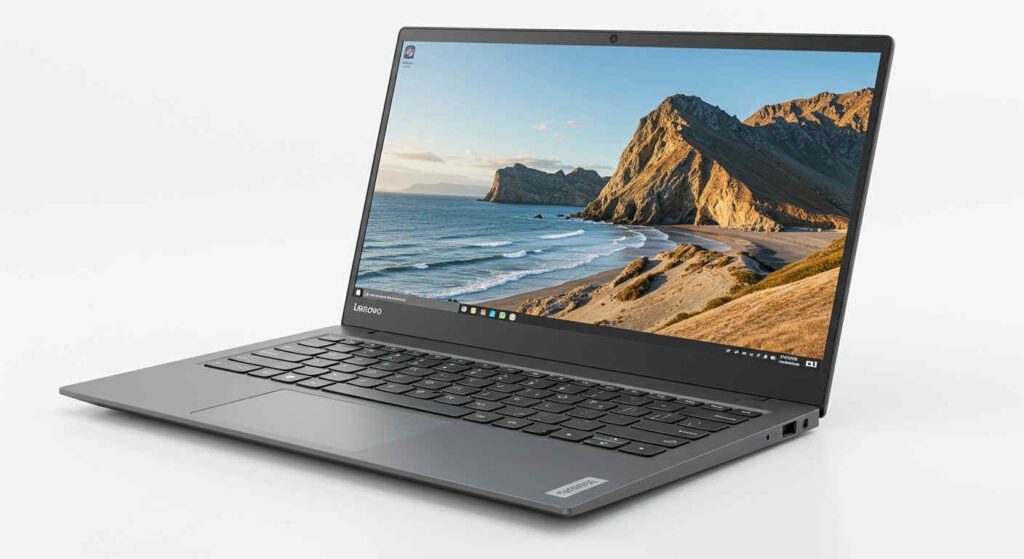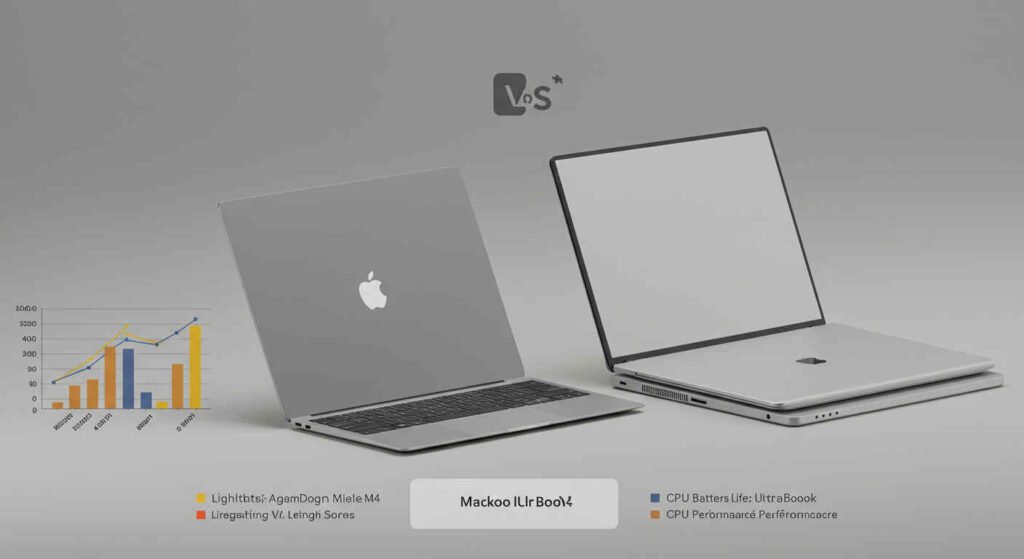MacBook Air M4 vs Windows Ultrabooks: Who’s Winning the Lightweight Crown?
Table of Contents
Introduction

Alright, y’all, strap on your boots and hold your hats, ‘cause we’re charging into the glitzy, high-speed showdown of lightweight laptops, the ultimate clash: MacBook Air M4 vs. Windows Ultrabooks, where the Apple MacBook Air M4’s locking horns with a crew of Windows ultrabooks like a lone ranger facing bandits at sunrise. These featherlight rigs—thinner than a diner pancake and lighter than a sack of cotton—are the rockstars of 2025’s tech world, zipping through your emails, games, and streaming binges without bogging down your backpack.
Holy guacamole, the MacBook Air M4’s galloping in with a shiny new chip, a slashed price tag, and a sky-blue strut, while Windows heavyweights like the Dell XPS 13, Lenovo Yoga Slim 7x, and ASUS Zenbook S14 are swinging with their own flair. This ain’t just a specs scrap—it’s a clash of spirits, a tussle for the throne of the ultraportable empire. So, grab a sweet tea, plop down, and let’s see who’s got the spunk to snag the lightweight crown, pointing to a future where slick power’s as easy as a Sunday breeze.
The Lightweight Frenzy: Why Slim’s the Big Deal in 2025
Let’s shoot straight—lightweight laptops are the bee’s knees in 2025, stealing the show like a fiddler at a hoedown. These ultrabooks, barely tipping the scales at under 3.5 pounds and slim as a whisper, are tailor-made for folks on the go—students, jetsetters, or digital wanderers chasing Wi-Fi like lightning bugs in July.
The MacBook Air M4, kicking off at a cool $999, is Apple’s silver bullet, slicing through the market with a fanless M4 chip that purrs softer than a kitten, a battery that lasts longer than a lazy river, and a design so sharp it could carve a roast. Meanwhile, Windows ultrabooks are storming in like a summer squall, packing Intel Core Ultra chips, AMD Ryzen AI processors, or Qualcomm Snapdragon X Elite, each itching to outshine the rest with dazzling OLED screens, clicky keyboards, and ports aplenty.
This battle’s a snapshot of our hustle-hard lives, craving tools that keep pace without dragging us down. The irony’s thicker than grandma’s gravy: these pocket-sized powerhouses pack more punch than desktops from a decade back, yet they’re scrapping over who’s the lightest feather in the hat. The MacBook Air M4’s price drop hums of a future where fancy tech ain’t just for fat wallets, while Windows ultrabooks sing a song of choice. Let’s meet the players and see who’s got the grit to rule the roost.
MacBook Air M4: The Sky-Blue Showstopper

First up, let’s eyeball the MacBook Air M4, Apple’s pride and joy, swooping in like an eagle on a crisp morning. Weighing just 2.7 pounds for the 13-inch model and 3.3 pounds for the 15-inch, this rig’s slimmer than a wafer at 0.44 inches and decked out in a new sky-blue shade that glimmers like a pond at twilight. Powered by the M4 chip—a 10-core CPU, up to 10-core GPU, and 16-core Neural Engine—it’s a silent stallion, fanless and cooler than a frosty lemonade, churning out Geekbench 6 scores around 3,780 single-core and 14,924 multi-core. That’s quicker than a hiccup, tackling 4K video edits, coding, or multitasking like a circus juggler with a dozen pins.
The 13.6-inch (2560×1664) or 15.3-inch (2880×1864) Liquid Retina display shines with 500 nits of brightness and over 100% sRGB coverage, though its 60Hz refresh rate feels like a slow waltz next to rivals’ 120Hz gallops. The 12MP Center Stage webcam’s a showstopper, keeping you framed like a Hollywood star on Zoom calls, while the four- or six-speaker system pumps out Dolby Atmos sound that fills the air like a thunderstorm. With 16GB of RAM standard and up to 32GB, plus a battery lasting 15 hours and 30 minutes, this Air’s a long-haul champ, not a short-dash sprinter.
But it ain’t all peaches and cream. The port lineup—two Thunderbolt 4 USB-C ports, a MagSafe charger, and a headphone jack—feels skimpier than a stingy tipper, and the glossy screen reflects light like a carnival mirror. Upgrading RAM or storage costs more than a night at a ritzy hotel, and gaming’s a weak link, with titles like Civilization VI limping at 30 fps. Still, the MacBook Air M4’s a beacon of effortless charm, its tight macOS integration and $100 price cut a siren song for Apple diehards and newbies alike, whispering of a future where power and portability dance cheek to cheek.
Dell XPS 13 (2024): The Windows Whiz

Now, let’s give a shout to the Dell XPS 13, a Windows ultrabook slicker than a hot rod and priced around $1,199. At 2.6 pounds and 0.60 inches thick, it’s a featherweight fighter, rocking a 13.4-inch display in FHD+ (1920×1200) or OLED (2880×1800) flavors, the latter boasting 400 nits and 100% DCI-P3 coverage for colors that burst like bottle rockets. Powered by Intel Core Ultra 7 155H or Snapdragon X Elite, it’s no slouch, hitting Geekbench 6 multi-core scores around 13,000, though it trails the M4’s lightning pace.
The XPS 13’s keyboard’s as snappy as a banjo string, and its glass touchpad glides smoother than a skater on ice. With two Thunderbolt 4 USB-C ports and a microSD slot, it’s got a smidge more connectivity than the Air, but you’ll need a hub for USB-A or HDMI. Its 55Wh battery holds up for about 12 hours, decent but shorter than the Air’s marathon run.
The 1080p webcam’s solid but lacks the Air’s auto-framing magic, and the speakers, while clear, don’t boom like Apple’s. The XPS 13’s a reflection of Windows’ versatility, running everything from Adobe to Steam like a champ, but its fan can buzz louder than a hornet’s nest under load, unlike the Air’s silent strut.
This ultrabook’s a warrior for options, its premium build and vibrant display a nod to a future where Windows rigs rival Apple’s sheen. But its higher price and shorter battery life are like thorns in your side, hinting that Dell’s chasing the crown but ain’t quite nabbed it.
Lenovo Yoga Slim 7x: The Vibrant Vibe

Next up, the Lenovo Yoga Slim 7x prances in like a show pony, priced at $1,299 and weighing a scant 2.8 pounds at 0.51 inches thick. Its 14.5-inch OLED display (2944×1840) dazzles with 1000 nits of brightness and 100% DCI-P3, making colors sing like a bluegrass band at twilight. Powered by the Snapdragon X Elite, it’s a speedster, hitting Geekbench 6 multi-core scores around 13,159, nipping at the Air’s tail.
The Yoga’s keyboard’s comfier than a rocking chair, and its touchpad’s precise as a hawk’s eye. With three USB-C ports (two USB 4.0), it’s got more hookups than a busy truck stop, and its 70Wh battery stretches to 14 hours, though it’s outpaced by the Air. The 1440p webcam’s crisp but misses Apple’s auto-framing flair, and the speakers deliver punchy sound but lack the Air’s spatial depth. The Yoga Slim 7x’s a canvas of creativity, its OLED screen and Windows flexibility a love letter to artists and gamers, with ray-tracing support for titles like Control running smoother than the Air’s gaming hiccups.
But here’s the kicker: its Arm-based chip can stumble on some Windows apps, like a foal finding its legs, and its price creeps higher than the Air’s. This ultrabook’s a bold splash, painting a future where Windows ultrabooks shine with display prowess, but it’s not quite the top dog.
ASUS Zenbook S14: The Quiet Contender

Hold your hat—here’s the ASUS Zenbook S14, slipping in at $1,149 and weighing 2.8 pounds with a 0.51-inch frame. Its 14-inch OLED display (2880×1800) glows with 500 nits and 100% DCI-P3, matching the Yoga’s brilliance. Powered by Intel Core Ultra 7 256V, it scores around 12,000 on Geekbench 6 multi-core, trailing the Air but plenty peppy for daily chores.
The Zenbook’s keyboard’s clicky as a typewriter, and its touchpad’s smooth as a summer breeze. With two Thunderbolt 4 USB-C ports, HDMI 2.1, USB-A, and a headphone jack, it’s got more ports than a bustling marina, outshining the Air’s sparse setup. Its 72Wh battery lasts 15 hours, neck-and-neck with the Air, and its cooling keeps it quieter than a church mouse under load. The 1080p webcam’s decent but no match for the Air’s 12MP clarity, and the speakers, while loud, don’t dance like Apple’s spatial audio.
This Zenbook’s a shadow of versatility, its port variety and OLED vibrance a nod to a future where Windows ultrabooks cater to every whim. But its slightly weaker performance and less polished software integration are like a faint hum, suggesting ASUS is close but not quite at the Air’s level.
Head-to-Head: The Down-and-Dirty Duel
Alright, let’s roll up our sleeves and throw these contenders into the ring like a barnyard brawl, breaking down the key showdowns that’ll crown the lightweight champ.
Performance: The Power Punch
The MacBook Air M4’s M4 chip is a firecracker, outrunning its rivals with a Geekbench 6 multi-core score of 14,924, compared to the XPS 13’s 13,000, Yoga Slim 7x’s 13,159, and Zenbook S14’s 12,000. It chews through video editing, coding, and AI tasks like a combine through wheat, thanks to its fanless design and Apple’s tight macOS integration. The Windows trio, with Intel, AMD, or Snapdragon chips, are no slackers, handling Photoshop, Premiere, and light gaming with spunk, but they can’t match the Air’s raw speed or silent swagger.
The irony’s thicker than sorghum syrup: the Air’s fanless setup throttles under marathon workloads, hitting CPU temps up to 102°C, while the Windows rigs’ fans keep them cooler but noisier. This hints at a future where quiet power might outshine raw grunt, but for now, the Air’s the performance king.
Display: The Visual Verve
The MacBook Air M4’s Liquid Retina display is sharp as a tack, with 500 nits and 100% sRGB, but its 60Hz refresh rate feels like a slow jog next to the Yoga Slim 7x’s 120Hz OLED, which dazzles with 1000 nits and 100% DCI-P3. The XPS 13’s OLED option and Zenbook S14’s OLED match the Yoga’s vibrance, outshining the Air’s glossy IPS panel, which reflects light like a still pond at noon.
The Windows ultrabooks’ displays are a canvas of dreams, their deeper blacks and smoother motion a love song to creators and streamers. The Air’s screen, while crisp, feels like a trusty pony—reliable but not the flashiest. The Windows trio snags this round, pointing to a future where vibrant visuals rule.
Battery Life: The Long-Haul Hustle
The MacBook Air M4’s a battery beast, lasting 15 hours and 30 minutes on a single charge, outrunning the XPS 13’s 12 hours, Yoga Slim 7x’s 14 hours, and Zenbook S14’s 15 hours. Its Arm-based M4 chip sips power like a camel at an oasis, while the Windows rigs, especially Intel-based ones, gulp more juice under load.
This battery battle’s a mirror of our go-go-go lives, craving devices that last from sunup to sundown. The Air’s endurance is a lighthouse, suggesting a future where unplugging’s a rarity, but the Zenbook’s close chase shows Windows is hot on its heels.
Portability: The Featherlight Fray
At 2.7 pounds and 0.44 inches, the 13-inch MacBook Air M4’s lighter and slimmer than the XPS 13 (2.6 pounds, 0.60 inches), Yoga Slim 7x (2.8 pounds, 0.51 inches), and Zenbook S14 (2.8 pounds, 0.51 inches). Its aluminum unibody feels like a finely bound book, sturdy yet sleek, while the Windows rigs, though premium, don’t quite match its featherweight finesse.
The Air’s portability’s a symbol of freedom, slipping into bags like a whisper, but the XPS 13’s slight weight edge keeps it in the fight. This round’s a coin toss, with the Air nudging ahead for its svelte silhouette, pointing to a future where laptops vanish into our lives.
Connectivity: The Port Powwow
The MacBook Air M4’s port lineup—two Thunderbolt 4 USB-C, MagSafe, and a headphone jack—feels like a light lunch compared to the Zenbook S14’s buffet of Thunderbolt 4, USB-A, HDMI, and more. The XPS 13 and Yoga Slim 7x offer a bit more with microSD or extra USB-C, but they still lean on hubs for legacy gear. The Air’s support for two external displays with the lid open is a new trick, but it’s outdone by the Windows rigs’ plug-and-play versatility.
This connectivity clash reflects our wired world, craving hookups for every gadget. The Zenbook’s port bounty’s a loud hoot for flexibility, while the Air’s minimalism whispers of a dongle-filled future, giving Windows the win here.
Webcam and Audio: The Virtual Vibe
The MacBook Air M4’s 12MP Center Stage webcam’s a gem, framing you like a pro on Zoom, while its four- or six-speaker Dolby Atmos system booms like a barn dance. The XPS 13’s 1080p webcam’s decent but static, and its speakers lack the Air’s depth. The Yoga Slim 7x’s 1440p webcam’s sharp but misses auto-framing, and its audio’s punchy but not spatial. The Zenbook S14’s 1080p webcam and loud speakers are solid but don’t sing like the Air’s.
The Air’s webcam and audio are a spotlight on our virtual lives, making calls and tunes a joy. The Windows ultrabooks hold their own but can’t match the Air’s polish, handing Apple this round and hinting at a future where multimedia shines.
Price and Value: The Wallet Wrangler
The MacBook Air M4’s $999 starting price (13-inch, 16GB RAM, 256GB SSD) is a bargain, undercutting the XPS 13 ($1,199), Yoga Slim 7x ($1,299), and Zenbook S14 ($1,149). But Apple’s upgrades cost more than a fancy steak supper—512GB storage adds $200, and 32GB RAM sends prices soaring. The Windows ultrabooks offer more base storage or OLED displays for similar prices, but their performance lags slightly.
The Air’s price cut’s a golden ticket, unlocking premium tech for less, while the Windows rigs’ versatility reflects a world of choices. The Air wins on raw value, but the Zenbook’s close, suggesting a future where affordability and power collide.
The Fine Print: What to Keep an Eye On
Let’s not kid ourselves—ultrabooks got their warts, like a shiny truck with a few dings. The MacBook Air M4’s port scarcity and glossy screen are like burrs in your boot, and its gaming chops are weaker than a kitten’s meow. Windows ultrabooks, while versatile, can hum like a fan in a windstorm, and Arm-based chips like the Yoga’s trip over some apps. Battery life varies, with Intel-based rigs trailing Arm’s efficiency, and upgrade costs across the board can sting like a wasp.
These quirks are the shadows in a bright spotlight, hinting that ultrabook tech’s still growing. But they’re also the spark that fuels progress, pushing brands to polish their game. Shop smart—check reviews, compare specs, and hunt deals to grab the best fit.
The Final Score: Who’s Snagging the Crown?
So, who’s the king of the lightweight hill? The MacBook Air M4’s a shooting star, its M4 chip, epic battery, and $999 price tag making it a fan favorite for students, pros, and Apple lovers. Its silent power, slick macOS, and sky-blue charm are a love letter to simplicity, outshining the Windows ultrabooks in raw performance and endurance.
The Dell XPS 13’s a stylish sprinter, its OLED display and premium build a nod to Windows’ polish, but it’s pricier and shorter-lived. The Lenovo Yoga Slim 7x’s OLED dazzles like a starry night, but its Arm quirks and cost hold it back. The ASUS Zenbook S14’s port bounty and quiet cooling are a versatile vibe, but it can’t match the Air’s speed or value.
The twist? These ultrabooks are neck-and-neck, each a brushstroke in a canvas of choice. The Air’s the crown-wearer for most, its balance of power, portability, and price a lighthouse for 2025. But if ports, OLED, or gaming are your thing, the Windows trio’s got your back. They’re a chorus of a future where lightweight laptops are as varied as wildflowers, letting you pick your perfect partner. So, size up your needs, chase those deals, and grab a rig that’ll soar with you—y’all, the lightweight crown’s shining brighter than a harvest moon!
See this another good article in our internal links: https://techforgewave.com/modular-pcs-upgrading-your-rig-w-empty-y-wallet/
See this good article on YouTube: https://youtu.be/2oeJsGVpEEo?si=JtLxHKZg_Cb1XeF7






